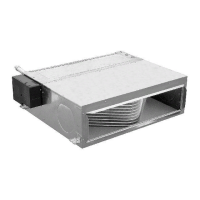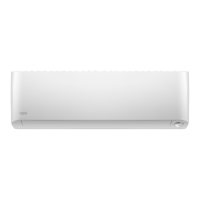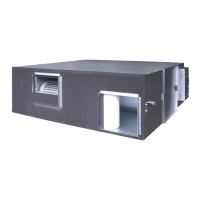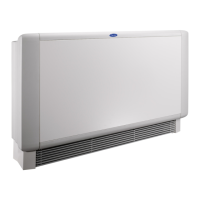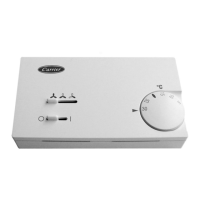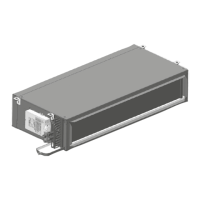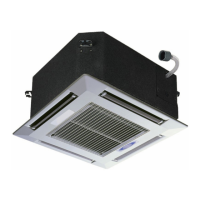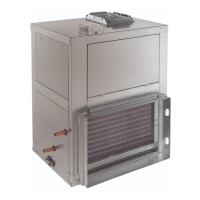41
Direct Expansion (DX) Cooling — The Unit Venti-
lator Comfort Control module is designed to provide up to
2 stages of capacity control for direct expansion (DX) cooling
applications. The control can be interfaced with condensing
units, unloader solenoid valve, hot gas bypass valves, and liq-
uid line solenoid valves. In these applications, the stages of DX
capacity are controlled to maintain the space temperature at the
cooling set point. Typically, compressor stages and liquid line
solenoid valves operate normally open, while unloaders and
hot gas bypass valves operate normally closed (see Fig. 31).
The Unit Ventilator Comfort Control module provides a
SPDT relay contact for the first stage of DX cooling. These
contacts are designed to switch up to 1 ampere of power (24 to
277 vac at 60 Hz).
Each DX output is configured to provide a minimum off
time of 5 minutes after being deenergized. This Time Guard
control feature allows the refrigerant pressures to equalize after
a compressor shutdown, thereby protecting compressors from
damage caused by starting with excessive loads. The Time
Guard control can be disabled if the stage is used to control a
solenoid valve or unloader.
OUTDOOR-AIR TEMPERATURE (OAT) LOCKOUT —
An outdoor-air temperature lockout is provided to disable all
DX cooling. The control compares the outdoor-air temperature
to the user-adjustable DX outdoor air lockout set point.
Whenever the OAT drops below the set point, all stages of DX
cooling are disabled.
The outdoor-air lockout feature is used to ensure the
condensing unit does not operate below its designed minimum
outdoor temperature.
DX System Design — Recommendations for basic DX
system design and piping should always be followed and are
available in the Carrier System Design manual.
The Unit Ventilator Comfort Control module maintains the
space temperature at the cooling set point by operating the DX
stages as the space load requires. Configuration requirements
for systems using DX components vary according to the
system design.
For units equipped with CCN controls, condensing units
should be sized for medium speed airflow unless a hot gas
bypass valve or two-stage condenser is supplied.
Several staging control examples for typical DX applica-
tions are shown in Examples 1-3. Use a service configuration
tool to configure the number of stages and the logic type and
Time Guard control features. See Set-Up, Configuration and
Operation section on page 46 for further configuration details.
Example 1 — Single-Stage Single Condensing Unit
Example 2 — Two-Stage Single Condensing Unit
*Optional, based on the system design or hot gas bypass.
Example 3 — Condensing Unit with
Two-Speed Compressor
The preceding examples are typical; however, staging for
each system is unique. Staging is for capacity control only and
does not eliminate any components required for safety or by
recommended system design. Follow equipment application
and installation instructions for sizing, location of electrical
connections, and required components such as liquid-line
solenoid valves used for refrigerant isolation, and thermostatic
expansion valves.
IMPORTANT: Never oversize the condensing unit.
STAGE
NUMBER
STAGE
TYPE
LOGIC
TYPE
TIME GUARD
FUNCTION
1 Compressor Normal Enabled
2 Hot Gas Inverted Disabled
STAGE
NUMBER
STAGE
TYPE
LOGIC
TYPE
TIME GUARD
FUNCTION
1 Compressor Normal Enabled
2
Electric
Unloader no. 1*
Inverted Disabled
STAGE
NUMBER
STAGE
TYPE
LOGIC
TYPE
TIME GUARD
FUNCTION
1
Compressor
or Low Speed
Normal Enabled
2
Compressor
or High Speed
Normal Enabled
24
56
1
3
NORMALLY
CLOSED
CONTACT
TERMINALS
NORMALLY OPEN CONTACT TERMINALS
COIL TERMINALS
RELAY CONTACT RATINGS
Fig. 31 — DX Control Relay (Part No. HN61KK324)
48 va at 24 vac 0.25 power factor
125 va at 115 vac 0.25 power factor
230 va at 230 vac 0.25 power factor

